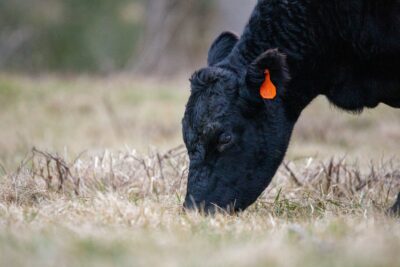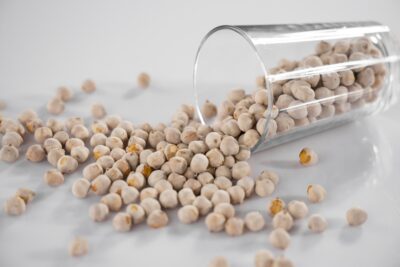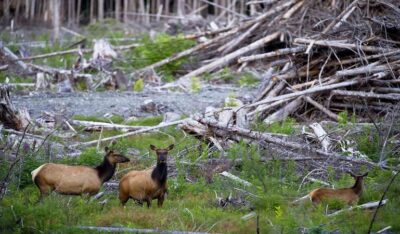Overgrazing is a common occurrence that, if left unchecked, can lead to the degradation and desertification of land. The main driver of overgrazing is animal agriculture, and specifically animals raised on pasture for their meat. High-end estimates suggest that as much as 3.3bn hectares of land are used as pasture for farmed animals. This represents a significant chunk of usable land which, if mismanaged, could fall victim to overgrazing. To avoid this farmers and policymakers need to ensure that they have land use plans that ensure the land is being used and managed responsibly.
WHAT IS OVERGRAZING?
Overgrazing occurs when too many grazing animals depend on a particular area for their food, and the vegetation is eaten by the animals more rapidly than it can grow back. The ecological and environmental impacts can be severe, including soil degradation and, eventually, desertification. Overgrazing is often the result of animal agriculture and has contributed to the degradation of land around the world.
WHAT IS AN EXAMPLE OF OVERGRAZING?
Naturalists have been sounding the alarm bells over levels of grazing in the New Forest for almost a decade. In an interview in 2019 Chris Packham claimed that the number of animals grazing in the area, which covers more than 500 sq km of land, was more than double what it should be. The animals, mostly cattle and ponies, are stripping tree bark and overgrazing the land. Two years later, during debates in the House of Lords, the claims were echoed by members who took steps to reform animal grazing in the area.
WHAT ARE THE CAUSES OF OVERGRAZING?
Though the primary cause of overgrazing is animal agriculture, there are a number of factors that contribute to the phenomenon. Among them are poor wildlife management, the circumstances of farmers, weather conditions, and irrigation.
1. LACK OF PROPER WILD ANIMAL MANAGEMENT
Like farmed animals, wild animals can overgraze an area. This has been the case in certain parts of the United States, where unbalanced deer populations contribute to the problem by consuming their preferred foods, eventually leading to the destruction of those plant species and the proliferation of less preferred plants, which are more likely to be non-native and to pose a risk to biodiversity.
2. ECONOMIC CONDITIONS FOR FARMERS
Another factor that can contribute to overgrazing is the profit margins of farmers. Allowing farmed animals to graze on pastures is cheaper than intensive farming, in which food is brought to the animals and they spend their lives indoors. Those farmers who have higher debt, low cash flow, and access to pastureland are likely to switch to pasture-raising the animals in their care. Unless the grazing is properly managed to prevent ecological destruction, this can contribute to overgrazing.
3. DROUGHT OR DECLINE IN PRECIPITATION
A lack of rainfall, or unseasonably warm weather, can make overgrazing more likely as animals continue to feed on grasses that are becoming dormant and not growing as quickly as they normally would in that season.
4. IMPROPER LAND USE
Using land in a manner that does not take its specific characteristics into consideration when determining appropriate uses — for example, the amount of rainfall, type of vegetation, and weather conditions — can contribute to overgrazing. Farmers who are raising animals on pasture must keep the unique characteristics of their land in mind when deciding how many animals to allow on one pasture and for how long.
5. OVERSTOCKING
Perhaps one of the most common agricultural mistakes that causes overgrazing is overstocking farmed animals. If land is not given adequate time to recover between grazing herds, or if too many animals are grazing on a particular pasture, the land is likely to be overgrazed.
WHAT IS THE PROBLEM WITH OVERGRAZING?
Overgrazing has severe ecological consequences, making land less fertile and damaging the livelihoods of farmers, reducing the capacity of the land to support plants and wildlife, and putting pressure on human resource use worldwide, compounding the problems of our global food system. It is often one of the first steps in processes such as desertification, in which drylands are converted into deserts, generally through poor management practices.
HOW DOES OVERGRAZING CAUSE SOIL EROSION?
Grasses and other plants act as anchors for soil, holding it in place. When overgrazing occurs and flora is destroyed, wind and water are more easily able to sweep the topsoil away.
HOW DOES OVERGRAZING CAUSE DESERTIFICATION?
Overgrazing is one of the main causes of desertification — the transformation of drylands into deserts. As the animals consume the local vegetation, the soil is both exposed to the elements as cover is removed, and compacted by the trampling of animals on bare earth, which damages the soil’s structure and impacts the land’s ability to support new growth.
LOSS OF VALUABLE SPECIES
As overgrazing destroys ecosystems, both plant and animal species are lost. The plant species preferred by the grazing animals are eaten first and do not have the time to recover, thus preventing them from maintaining their population. As overgrazing alters and destroys the ecosystem, the animals that once thrived are driven away due to habitat loss.
FOOD SHORTAGES
Soil erosion, which is one of the impacts of overgrazing, is a leading cause of food insecurity and can decrease crop yields by up to half. Because soil erosion includes the loss of nutrients in the soil, the crops that do grow are often not of the same quality as crops grown in areas without soil erosion.
DEATHS OF PEOPLE AND FARMED ANIMALS
Estimates suggest that at least 951 million people are likely to be impacted by desertification, a number that increases with more pessimistic assumptions about the rate of global temperature rise due to climate change. Desertification is a process that often starts with overgrazing, and the persistence of overgrazing will mean continuing impacts on additional people as well as the animals they depend upon. Food insecurity will worsen, global food prices may rise, and the result will be hunger.
DEFORESTATION
Overgrazing can drive deforestation. Forests themselves can be overgrazed, and as land worldwide is depleted forests are destroyed to create more pasture for grazing animals.
HOW DOES OVERGRAZING AFFECT EARTH?
Overgrazing has massive impacts on the planet, causing profound negative impacts on ecosystems and driving global warming.
ECOLOGICAL IMPACTS
Overgrazing leads to biodiversity loss, especially the loss of plant species. This is due to grazing animals preferring particular plants which they are likely to overconsume, leading them to decrease and eventually disappear from the ecosystem. The loss of plant species can have knock-on effects, making the area less hospitable to established wildlife.
GLOBAL WARMING
Overgrazing and global warming act as parts of a vicious cycle, each of them contributing to the other. Increasing temperatures can expedite the transition from overgrazing to desertification, while overgrazing causes soil erosion which releases carbon into the atmosphere expediting global warming.
WHAT ARE THE SOLUTIONS TO OVERGRAZING?
Thankfully there are ways of restoring land that has been overgrazed, and preventing further overgrazing from happening in the future.
PROPER MANAGEMENT OF ANIMALS
Whether farmed animals or wildlife, there are ways of managing animals to prevent overgrazing. For wildlife, non-lethal methods of population control can be pursued. Within animal agriculture, reducing the number of animals being raised for food and using rotational grazing techniques can protect the land.
LAND USE MANAGEMENT
Perhaps one of the most pressing ways to prevent overgrazing is to change the way that land is managed to be more sustainable. When creating a land use plan, it is important to take into account the type of land being used and implement methods that are appropriate.
SUSTAINABLE PASTURE PRACTICES
The most sustainable pasture practices are those that move the grazing animals across a series of small paddocks relatively quickly. This method works to ensure that no one area is overgrazed.
MONITOR PASTURES AND GRAZING BEHAVIOUR
Another important part of preventing overgrazing is to monitor the pastures and the grazing behaviour of the farmed animals. This means understanding which seasons see less growth, how long the land needs to recover from a period of grazing, which plants the animals prefer and are likely to consume the most of, and how many animals a particular pasture can actually support.
CONCLUSION
Overgrazing represents a significant threat to food security, biodiversity, climate change, and the environment. Without proper management of pastureland species will be lost, global warming will worsen, more people will risk going hungry, and we, as a global community will suffer.
Many of us have never been on a farm, let alone helped to make decisions about how pasture is used and managed. However, we are still able to influence land use through our dietary decisions. Choosing not to eat meat, especially from animals who are raised on a pasture, will reduce the overall number of animals being raised on pasture and the likelihood of overgrazing.





